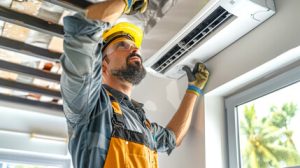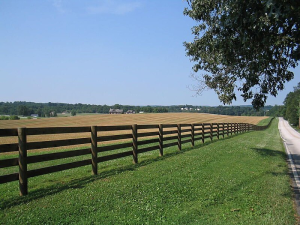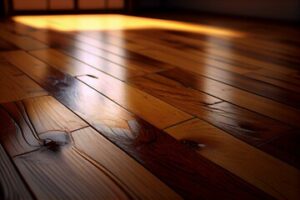Performing regular AC maintenance is essential to maintaining optimum efficiency levels. These activities include cleaning filters and inspecting system components for problems like clogged drain lines or low refrigerant levels.

However, there are some AC issues that cannot be prevented with routine maintenance alone. These problems can require the expertise of AC Repair Round Rock technician to resolve.
Airflow problems are among the most common AC repair issues that HVAC technicians encounter. Restricted airflow causes your HVAC system to struggle to keep your home cool, and it can lead to expensive electricity bills. Luckily, addressing these issues is fairly simple and inexpensive.
The blower motor, located inside the air handler, is a major component that helps to push conditioned air throughout your home’s ductwork. If the blower motor becomes dirty it can significantly impact the airflow in your house and may need to be cleaned or replaced.
Dirty air filters, clogged condensate drain lines, and frozen evaporator coils are all issues that can cause restricted airflow in your home. If these are not addressed in a timely manner, it can put unnecessary strain on the compressor which leads to a shorter system lifespan and high electric bills.
Blocked vents and registers are one of the most common HVAC airflow problems, especially in homes with multiple occupants. If your AC registers or vents are blocked by furniture, pet beds, or toys it can prevent the air from reaching those areas of your house. You can check this by turning off your AC, and then looking for a warmer room to see if any of the vents are closed or blocked.
Another common cause of reduced HVAC airflow is an improperly calibrated or malfunctioning thermostat. If you notice that your air conditioning is running more often than it should be, this can indicate that the thermostat is not properly calibrated and needs to be adjusted or replaced.
Other HVAC airflow issues that you should seek professional help for include:
Some problems with your AC unit can be handled on your own, but there are many things that require the expert knowledge of a trained repairman. Some of these tasks can be dangerous, including working with electrical components or handling refrigerant. It is also not recommended that you attempt a DIY AC repair on your own, especially if you do not have the proper tools or training. Having the right equipment and knowledge to work safely with your heating, ventilation, and air conditioning system will save you time and money in the long run.
Water Leaks
There’s nothing more unnerving than seeing water dripping from your ceiling or pooling in the floor of your mechanical room. This is a sign that your air conditioning unit is leaking water. Water leaks are not only unsightly but can also cause costly damage to your equipment and the structural integrity of your home or office.
One of the most common reasons for AC leaking water is because the drain line that directs condensation outside has become disconnected or damaged. This is an easy fix for an HVAC technician, and it can help prevent a serious water disaster from occurring in your home.
Another reason your AC might be leaking water is because the evaporator coil is clogged with debris. A simple air filter change can solve this issue, but if the evaporator coil is damaged, you’ll need to contact an HVAC contractor for more comprehensive repairs.
If your AC leaking water is due to a cracked or damaged drain pan, you’ll need to have this replaced as soon as possible. A temporary solution might involve using water-resistant sealant or epoxy putty to patch any cracks or holes, but a permanent repair will usually require a professional installation of a new drain pan that’s compatible with your air conditioner.
Your air conditioner might also be leaking water because the evaporator coil has frozen over. This can be caused by low refrigerant levels, so it’s important to have your system checked and refilled regularly.
A clogged or dislocated thermostat could be the culprit of your AC leaking water. It’s not uncommon for this part to break down over time, which can lead to insufficient cooling and a number of other issues.
If you suspect that the thermostat is the source of your leaking water, you can try to clear a clog yourself by removing the access panel and examining the drainage line for any obstructions. You can then use a pipe cleaner or wet/dry vacuum to remove any debris from the drain line, and you can flush it with water if necessary. If this doesn’t work, you should contact a professional to handle the job as it requires specialized tools and knowledge.
Unusual Noises
Unusual noises from an AC unit can often be a warning sign of an underlying problem that could become more severe. If left unaddressed, these issues could lead to costly repairs or even a system replacement. The key is to understand what different sounds mean so you can take action as soon as possible.
If you hear a clicking sound while the air conditioner is running, it’s important to turn off the unit and call a professional. A constant clicking noise is typically a sign of an electrical problem that could result in a fire within the unit or in the home’s walls. Electrical problems are difficult and dangerous to handle on your own, so it’s best to leave them to the experts.
Rattling and clanking sounds are another common warning signs. These sounds are typically caused by loose screws and bolts that bang against other components inside the unit. A simple fix like replacing the fan belt or fan blade should resolve this issue, but in some cases, you may need to consult a professional to repair the motor or other more serious components.
Squealing and screeching sounds can also be a warning sign. These high-pitched noises are often a sign of a worn-out fan belt or damaged motor bearings. Over time, these problems can reduce your AC’s efficiency and cause damage to other components if not addressed in a timely manner.
A humming sound can be a sign of an issue with the contactor relay switch or a capacitor, which controls the AC’s motor. These issues can cause vibrations in the refrigerant piping or create an electrical short. In some cases, a humming sound can also be a sign of low refrigerant levels.
A whistling sound can be a sign that there’s a leak in the ductwork. In some cases, this might be as simple as a clogged air filter or blocked vents. However, in other cases, the problem might be much more serious, such as a refrigerant leak or frozen evaporator coil.
Frequent Breakdowns
Air conditioning units are critical to maintaining comfort in homes and businesses. However, they are susceptible to a range of issues that can impact their efficiency and lead to breakdowns. Recognizing the warning signs of AC problems and implementing effective repair solutions can reduce expensive repairs, extend the lifespan of your unit, and improve its performance.
Often, frequent breakdowns are an indication that it’s time to consider replacing your system. This can be a daunting expense, but it may offer significant savings in energy costs and comfort.
Thermostat Problems
A thermostat malfunction can cause your system to cycle on and off intermittently or fail to maintain the desired temperature. This is often caused by an incorrect calibration, dead batteries, or sensor issues. Alternatively, it could be as simple as a dirty air filter that causes the system to work harder than it should.
Clogged Condensate Line
A clogged condensate line prevents the system from draining properly and can lead to water damage, causing severe system failure. Luckily, this issue is easy to fix by clearing out the line using a wet/dry vacuum or flushing it with water.
Unusual Noises
Unusual noises like banging, clanging, or buzzing are a red flag that there is a serious problem within the AC system that requires immediate attention. This could be a sign that the system is rusted and needs to be replaced, or it could indicate electrical problems that need professional help. You should also pay attention to any strange smells. A musty odor could mean mold or mildew in the ductwork, while a burning smell indicates faulty wiring and needs to be addressed immediately.
Performing routine maintenance on your system, such as changing filters monthly and ensuring that the outdoor unit is free from obstructions, can extend the life of your AC system and minimize the need for costly repairs. Addressing these underlying problems will also keep you comfortable throughout the summer while improving your energy bills and reducing your environmental footprint. For homeowners with old or inefficient systems, investing in a new system can offer even greater energy savings and offset the initial investment over time.








